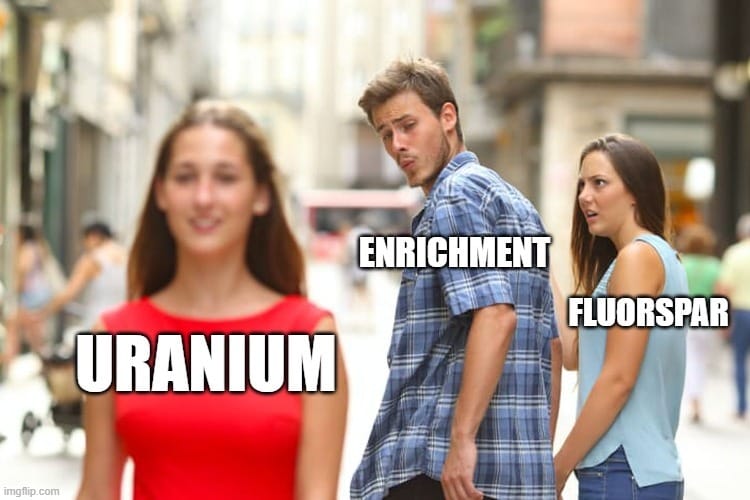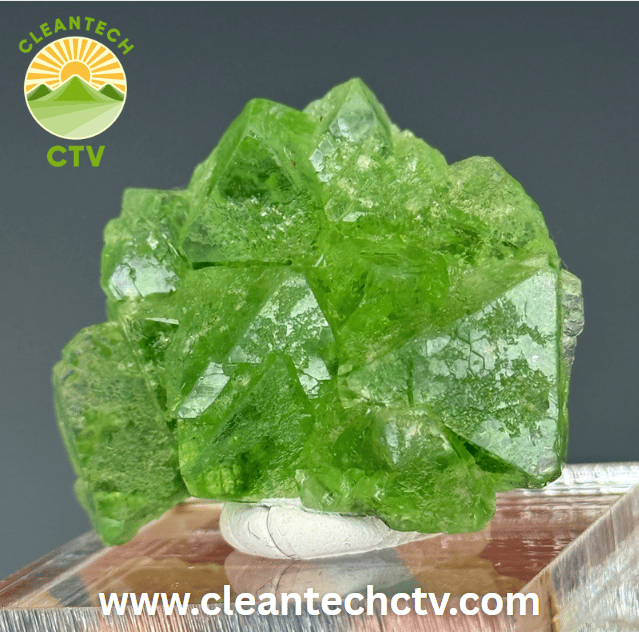- Nuclear Update
- Posts
- ⚛️Fluorspar: The Key Mineral for Enrichment
⚛️Fluorspar: The Key Mineral for Enrichment
This is not the weekly update, that one will hit your inbox on Monday. Today we’re doing another deep dive, and this time we’re zooming in on one of the most overlooked choke points in global energy security: fluorspar. Without it, enrichment stalls, reactors go quiet, and the rest of our clean energy plans start to wobble.

Welcome to Nuclear Update.
This is not the weekly update, that one will hit your inbox on Monday.
Today we’re doing another deep dive, and this time we’re zooming in on one of the most overlooked choke points in global energy security: fluorspar. Without it, enrichment stalls, reactors go quiet, and the rest of our clean energy plans start to wobble.
Don’t believe me? Fluorspar was put on the U.S. critical minerals list back in 2022, long before tariffs and trade wars became headline news.
This deep dive is sponsored by CleanTech CTV, but that’s ok, because CleanTech CTV happens to be doing some very interesting things in this exact space. They’re reviving America’s old fluorspar heartland right as the mineral is becoming critical again, and their story is worth your attention.

⚛️Fluorspar: The Key Mineral for Enrichment
Uranium is the rockstar of the nuclear story. But every star needs a stage crew.
Fluorspar is one of those behind-the-scenes minerals that nobody cheers for, yet everything falls apart without it.
Fluorspar (or fluorite) is a naturally occurring mineral made of calcium and fluorine (CaF₂). It comes in colorful crystals, purple, green, even transparent, and has been mined for centuries for uses ranging from steelmaking to optics.
But its real superpower today is being the world’s main source of fluorine.
And fluorine is the key to turning uranium into a gas (UF₆) for enrichment.
No fluorspar, no UF₆. No UF₆, no enriched fuel. Simple as that.

🔄 How Fluorspar Becomes UF₆
Here’s where it gets fun. You’ve heard the words ‘conversion’ and ‘UF₆’ before, but let’s slow it down and walk through the chemistry step by step, and see how fluorspar makes it all possible.
Start with fluorspar (CaF₂), the natural mineral.
Process it into hydrofluoric acid (HF). This is where most of the world’s fluorspar demand goes, more than half of all mined material becomes HF.
That HF is then used to convert uranium concentrates (U₃O₈), what we call yellowcake, into uranium tetrafluoride (UF₄).
Next, UF₄ is fluorinated further into uranium hexafluoride (UF₆), a compound that turns into a gas at relatively low temperatures (56 °C).
And here’s the kicker: enrichment only works on uranium in gaseous form, so UF₆ is the essential feedstock for enrichment plants worldwide.
For a quick dive deeper, check out this article or video below on what it takes to enrich uranium:
So yes, when you hear about centrifuges spinning at Paducah or enrichment cascades in Russia, none of that happens unless there’s fluorspar mined, refined, and piped into the system.
This is the invisible choke point. If HF supply stalls, conversion stalls. If conversion stalls, enrichment stalls. And if enrichment stalls, nuclear plants run out of fuel. It’s a straight line from obscure Kentucky rock to the grid powering your lights.
🌐Fluorspar Shows Up Everywhere
It would be easy to frame fluorspar as “the mineral that makes UF₆ possible” and stop there. But that would sell it short. In reality, fluorspar quietly underpins industries you interact with every single day.
Batteries – The electrolyte in most EV and energy storage batteries is called lithium hexafluorophosphate (LiPF₆). You can’t make it without HF, and you can’t make HF without fluorspar.
Semiconductors – Fluorine gases are the hidden tools of chipmaking. They etch the tiny patterns on silicon chips and keep equipment clean between runs. Every phone, every data center, and every AI processor depends on them.
Power grids – Sulfur hexafluoride (SF₆) is the standard insulating gas in high-voltage equipment. It’s what keeps your grid stable even when power loads spike.
Refrigerants & non-stick coatings – HF is the starting point for refrigerants and for Teflon (PTFE). Whether it’s cooling your fridge or keeping your frying pan non-stick, fluorspar is quietly doing the work.
Steel & aluminum – Fluorspar helps make steel by removing impurities and improving heat transfer. In aluminum, it appears as cryolite, which is key to the smelting process.
Glass & ceramics – HF made from fluorspar is what allows precision glass etching, whether it’s for high-tech optics or architectural finishes.
In short, fluorspar is woven into everything from the energy transition (EVs, grids, nuclear) to modern tech (chips, semiconductors) to old-school heavy industry (steel, aluminum, glass).

In 2024, U.S. production of fluorspar was basically zero. Imports keep the whole system afloat. Meanwhile, China controls over 60% of world supply, and prices in the U.S. climbed roughly 50% in four years. That’s what dependency looks like.
It’s not just a trade issue, it’s a national security one. Nuclear fuel cycles, EV batteries, semiconductors, all of them rely on steady access to HF (and therefore fluorspar.)
If supplies tighten, you don’t just see higher prices, you risk shutdowns in critical industries.
When China briefly cut rare earth exports to Japan in 2010, it shook global supply chains and forced countries to rethink their entire resource strategy.

Fluorspar hasn’t had its “rare earths moment” yet, but it’s sitting in the same waiting room. Western governments already know it, the U.S. added fluorspar to its official list of critical minerals, the EU calls it strategic, and both blocs are funding domestic projects to avoid single-source dependency.
But the bottleneck is tighter than it looks. It’s not just about mining fluorspar. You also need the refining capacity to turn CaF₂ into HF and then into downstream products. Most of that midstream capacity is also in China, which gives Beijing outsized leverage over the whole chain.
The result is a material nobody talks about is suddenly positioned at the heart of the energy transition, the nuclear revival, and the semiconductor race.
📊 The Supply-Demand Squeeze
The entire global fluorspar market is only about 10 million tonnes per year, a drop in the bucket compared to iron ore, copper, or even lithium.
Yet demand keeps climbing. More than 70% of mined fluorspar is refined into acid-grade material, the high-purity feedstock that makes hydrofluoric acid.
Over half of that HF then flows straight into sectors powering the 21st century: nuclear fuel, lithium-ion batteries, semiconductors, and grid infrastructure. Nuclear alone consumes 50–60% of HF output.
On the supply side, China dominates with nearly 6 million tonnes per year, Mexico and Mongolia provide another 1.2M each, and the U.S. has none. That imbalance means any hiccup in Chinese output or exports can ripple across global supply chains instantly. Which could happen in the foreseeable future as China is running out of its fluorspar reserves.

Prices tell the story. In China, fluorite spot price has risen 15% over the past 2 months. In the U.S., fluorspar climbed from ~$309/ton in 2020 to around $406/ton in 2025, and analysts expect the squeeze to intensify as EV adoption surges, chip fabs scale, and nuclear expansion accelerates.

A market this small, this concentrated, and this essential is exactly how you get a resource bottleneck that suddenly becomes front-page news.
🏗️ Enter CleanTech CTV
So where does CleanTech CTV fit into this story?
They’re a Canadian-listed critical minerals company (cleantechctv.com) (TSXV: CTV.v; OTCQB: CTVFF) focused on two big themes:
Reviving U.S. fluorspar production through a large land package in the historic Illinois-Kentucky Fluorspar District, once America’s main source of this vital mineral.
Developing vanadium supply through the Gibellini Project in Nevada, which already is advancing as what could become the first primary vanadium mine in the United States.
In plain English, CleanTech CTV is positioning themselves as a supplier of strategic inputs that Western supply chains desperately need, fluorspar for conversion and batteries, vanadium for grid-scale storage and steel.
The location is critical here. The Illinois-Kentucky Fluorspar District is the only part of the United States that has ever produced fluorspar in serious volumes. For most of the 20th century, this district supplied domestic industry before collapsing under global competition in the 1990s.
Now, with supply chains tightening and prices rising, it’s once again in the spotlight. CleanTech CTV controls more than 8,150 acres across Kentucky and Illinois, with hundreds of historic drill holes pointing to significant mineralization. You can read more about their fluorspar projects here.
On the vanadium front, Nevada’s Gibellini Project gives CleanTech CTV another U.S.-based asset in a state with a long mining tradition and established infrastructure. Being in Nevada means easier permitting pathways, workforce access, and proximity to U.S. grid and battery developers who increasingly want a secure, domestic vanadium source.
So their role today is part explorer, part developer: proving up old resources with modern work, and moving toward the day when America has a homegrown fluorspar and vanadium pipeline again.
With U.S. critical minerals lists growing longer and geopolitical shocks more frequent, CleanTech CTV is betting reviving domestic fluorspar production looks less like nostalgia and more like insurance.
And the fact they’re doing it in historically proven districts, rather than trying to invent new ones, makes the bet a lot more credible.


⚡ Wrapping Up
Fluorspar has not made headlines yet like uranium or lithium, but that doesn’t make it less important. It’s the quiet backbone of enrichment, batteries, semiconductors, and the power grid itself.
Right now, the U.S. has no domestic production. That’s why projects like those CleanTech CTV are advancing in Kentucky, Illinois, and Nevada matter more than most people realize.
Because at the end of the day, no fluorspar means no HF. No HF means no UF₆. And without UF₆, the nuclear renaissance doesn’t even get out of the starting blocks.
– Fredrik
For more information on CleanTech’s fluorspar initiatives, visit their website or contact John Lee at [email protected].
What did you think of this week's email? |
DISCLAIMER: None of this is financial advice. This newsletter is strictly educational and is not investment advice or a solicitation to buy or sell any assets or to make any financial decisions. Please be careful and do your own research
Reply